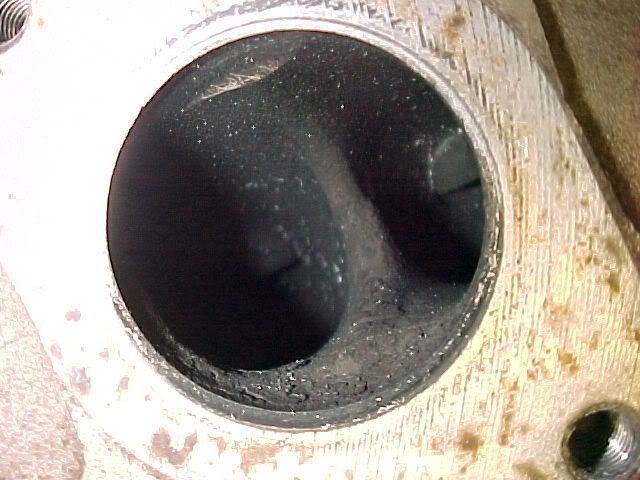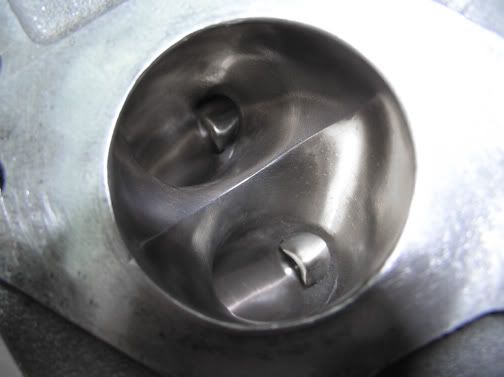i have a spare engine head laying around for the geo, wondering if there is a DIY port and polish video anyone has seen on the web. i have a compressor, and die grind kit, what else do i need to have? i would do the exhaust at the same time. i have too much time on my hands.
Ooh, count me in on this, too. I need need need to get my 460 heads moving, and I'm planning to do the same.

JThw8
Dork
7/21/08 5:41 p.m.
Not free but for $10 I've bought some of this guys other videos and they are pretty informative
http://cgi.ebay.com/ebaymotors/PORT-PORTING-and-POLISH-POLISHING-KIT-RACE-HEADS-DVD_W0QQcmdZViewItemQQ_trksidZp1742Q2em153Q2el1262QQcategoryZ33617QQihZ001QQitemZ110270080995QQtcZphoto
i think i am just going to end up polishing the exhaust exits and exhaust manifold. any tips would be super
You know, a while back David Vizard wrote a story on DIY head prep for this little magazine called Grassroots Motorsports.
I'll look around for the links I bookmarked when I was looking for this stuff for my BBF and post up here. Watch this space...

ratghia
New Reader
7/21/08 6:58 p.m.
Just don't try this. link (post from audiform)
Hey guys, I've got a 98 1.8T. I've had a k04 and chip for a while and wanted to get more performance. I was recommended to port and polish the intake and exhaust. We found out they used abrasive material to do it like gritty sand. So I got with my friend that tunes Hondas and we decided to try it ourselves. We got a bag of sandblasting sand and hooked up into the intake and started the car. We had to hold the gas so it would run. He wanted to let the engine suck in the sand through the intake so it would port it out and then push it out the ehxaust so it would port the exhaust manifold.
I was worried that it might cause problems but he figured it'd be OK as long as we didn't make boost and it get sucked in the turbo. After running the car and letting it suck in sand we got about half way through a 25 lb bag. The check engine light was on and the engine was bucking and kicking and sounding really weird. We stopped and hooked the car back up normal and took off the sand supply. We tried to start it again and it was really hard. Once started it couldn't idle and kept making weird noises. We took it out and drove it and it started to make scraping and knocking noises.
Help! Can anyone tell me what to do! My buddy only does Hondas so he doesn't know much about Audis.
no way. theres no way that actually happened someone kill that guy.
someone kill that guy.

Dorsai
New Reader
7/21/08 8:20 p.m.
Just run it in reverse. That ought to blow it out.

Billzilla sez that most modern engines are pretty well designed and you're not going to get much from porting them. However, you can polish them and get a little. Check out billzilla.org for more info on engines than you'll ever remember.
I believe polishing will help. Some of those casting fins Ive seen in some engines running down the line are alittle big for my liking.

look at this for starters: sa-motorsports.com/diyport
first timer here - I've been playing with a junk head for the last 2 months getting a feel for it and am about to start on my good casting. probably an excessive amount of practice time but I believe it was time well spent.
tools: using a 1/4" electric Makita grinder through a foot pedal speed controller, also have an adjustable speed Dremel w/flex shaft attachment for getting to some difficult areas.
cartridge rolls: tootsies and tapered, I think 80 & 120 grit. scored a stuffed ziplock bag full of them with 2 mandrels for very cheap off ebay.
take a pretty long 1/4" bolt w/smooth shank, lop off head and cut a slot an inch down the center - long folded sand paper strips fit nicely, poor mans flap wheel. I use this w/finer grit on the exhaust side before polishing.
also have these 3 shapes of carbide burs:



the burs remove a lot of material very quickly, I've only used them to open up to the gasket lines. just about everything else is done with the rolls.
I have some kind of soft wax stuff, dip the burs in every few moments, helps keep the heat down. a thin layer smeared in the ports before hitting w/cartridge rolls helps reduce the dust.
polishing - i have some dense white cloth rolls, wheels and a bullet shape that came w/Dremel kit. also had some polishing compound of some sort. they seem to work pretty good, almost mirror finish after 320 paper.
if you do work in the chambers get a set of sacrificial valves to protect the seats.
wear glasses and a dust mask, earplugs are nice too!
keep in mind- you dont want it perfectly smooth, you want a "hone" effect. air is Viscous and if the port is mirrior-smooth the air will stick to it like water in a glass (what do they call that again? arg, cant remember) the slight roughness helps break that up and let the air "slip" through easily
surface tension
the slight roughness makes the air tumble as its going down the intake which helps with the fuel/air mixing and atomization
FWIW you're not going to want to do this with a cheap air die grinder and small compressor.
You'd do better with an electric and a router speed controller from HF.
Polishing the exhaust ports and combustion chambers, and port matching the intake ports to the manifold might might be the best route for a beginner.
Also, go in stages lest you get bored/discouraged halfway through CYL 2.
-James
I can't endorse using epoxy in the intake ports ( or exhaust for that matter..)
see the sandblast method posted above!
Just go easy and lightly polish.
( and if it's your first experiment .. keep a spare head handy !)
Yep, what they said.
BobOfTheFuture wrote:
keep in mind- you dont want it perfectly smooth, you want a "hone" effect. air is Viscous and if the port is mirrior-smooth the air will stick to it like water in a glass (what do they call that again? arg, cant remember) the slight roughness helps break that up and let the air "slip" through easily
That's for the intake side, go ahead and polish the crap out of the exhaust side. Here's some of my work.
Before:

After:


amg_rx7
New Reader
7/22/08 11:26 a.m.
I once ported the heads on my A1 VW. I basically match ported so that it was close to the intake gasket size. Didn't work out very well. Car wasn't any faster feeling and felt a bit less responsive at part throttle. I had access to the tools but no real knowledge of what I was doing.
I use a thing called a whip, I've donated some to fellow GRMers before. Take a 1/4" rod and drill a slot down the center of one end, about 1/2" down. Rip a strip of emmery and fole it in half; slide it into the slot. Pretties up the holes nicely.
Also good for a close tolerance hole with oxidation or a burr in it.
Keep in mind that most porting jobs result in less power. Most folks don't know what they are doing, and screw things up worse than stock as a result. And this includes a whole lot of so called speed shops.
If you're determined to do the job (and I suggest you do so), evaluate carefully where bottlenecks are, and do the work to reduce them.
Make a flow bench with a shop vac and a ping-pong ball. Then you can maybe see if your improvements were improvements.

YaNi
New Reader
7/22/08 3:08 p.m.
foxtrapper wrote:
Make a flow bench with a shop vac and a ping-pong ball. Then you can maybe see if your improvements were improvements.
That's a good idea. If you hooked a shop vac to blow into one end and had a clear pipe attached to the other with a ping pong ball in it, you could measure the height of the ball in the tube.
Another method could be to use the shop vac and connect a precise vacuum/pressure gauge to the inlet/outlet; Dwyer Magnahelic gauges can be found on ebay for <$20. FYI 1 PSI = 27.78 Lbs of Water, so some of these gauges can detect minute changes in restriction.

Hi, the most common mistake made when porting, is to enlarge the ports to the gasket size. Owr engines depend on vacuum to draw in fuel and air. The bigger one makes the port the less the velocity of the air and charge one introduces into the cylinder,since vacuum values remain constant. ENLARGE TO THE SIZE OF THE INLET VALVE AND NO MORE. Polish to a mirror finish. I don't buy the honed finish hypothesis, since water as much as air slide quicker on polished areas. Try this with a new glass and one that has been washed in a dishwasher for sometime and the surface has roughened up. the latters slip coefficient is a much lower value. For emulsification we have the so called emulsion tubes in carbs.( of-course we should be usind webers, dellortos or holleys only, no SU or stromberg nonsence). Now if we want to increase vacuum, we have a few ways at owr disposal. Namely, 3 angle valve seats, gapless rings, stroking and last but not least, increasing the compression. Don't go mad on this one since you will introduce detonation into the equation. This depends on the fuel you are using, but for pump fuel, i wouldn't go more than 9.7:1. Now think about extracting the burned charge. The hotter the gases, the more the velocity. Paint the primaries white, or insulate them. I could go on forever, but for now I'll grab myself a brew.
Rough surface increase the boundary layer, reduces the effective cross sectional area a bit, but the overall decrease in drag overcome that.
It's why golf balls have dimples, makes them fly farther.














































